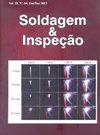Influence of Push and Pull Techniques on High-Speed Buried-Arc GMAW Process
IF 0.3
4区 材料科学
Q4 METALLURGY & METALLURGICAL ENGINEERING
引用次数: 1
Abstract
The GMAW torch orientation, whether pulling or pushing, influences both arc welding and hybrid processes. In hybrid laser-arc welding, for example, when the torch is pulled, a greater bead penetration is obtained. To promote greater penetration, the literature also indicates the use of a buried arc in GMAW, although it was initially developed to only operate with a vertically-positioned torch. Therefore, this work aims to investigate the influence of the push and pull techniques on the behavior of buried-arc GMAW at high welding speeds. Welds were performed with the push and pull techniques under the following conditions: buried and unburied (long) arc with welding speeds of 1.0, 1.5 and 2.0 m/min and current ranging from 450 to 470 A. The process tends to be more stable when pulling than when pushing (buried or long arc). Evidence of instability was only identified for the pushed buried arc, due to material accumulation at the front region of the molten pool, for the higher welding speeds. Only the 1.0 m/min buried-arc processes resulted in beads with an appropriate surface finish. Key-words: Buried arc; GMAW stability; Molten pool; Humping.推拉技术对高速埋弧GMAW工艺的影响
GMAW焊枪的方向,无论是拉焊还是推焊,都对弧焊和复合焊工艺产生影响。例如,在混合激光弧焊中,当焊枪被拉起时,焊头的熔深更大。为了促进更大的穿透,文献还表明在GMAW中使用埋弧,尽管它最初仅用于垂直定位的火炬。因此,本研究旨在研究高焊接速度下推拉工艺对埋弧焊头性能的影响。在埋弧焊和非埋弧焊(长弧)条件下,采用推拉焊技术进行焊接,焊接速度分别为1.0、1.5和2.0 m/min,电流范围为450 ~ 470 A。该过程往往在拉时比在推时更稳定(埋弧或长弧)。由于较高的焊接速度,由于熔池前部区域的材料积累,仅在推埋弧中发现了不稳定的证据。只有1.0 m/min的埋弧工艺产生了具有适当表面光洁度的珠子。关键词:埋弧;熔化极气体保护焊-稳定;熔池;呈驼峰状。
本文章由计算机程序翻译,如有差异,请以英文原文为准。
求助全文
约1分钟内获得全文
求助全文
来源期刊

Soldagem & Inspecao
工程技术-冶金工程
CiteScore
1.00
自引率
16.70%
发文量
13
审稿时长
12 weeks
期刊介绍:
The Journal Soldagem & Inspeção (S&I) js a techno-scientific journal created in 1995. Printed issues of this journal are distributed free of charge to libraries in Brazil, Latin America and the Iberian Peninsula. It has been printed regularly every quarter since September, 2002, and, since the beginning of 2007, its electronic version is available in the address: (http://www.abs-soldagem.org.br/s&i/). The journal is sponsored by the Brazilian Welding Association (ABS).
Since its creation several well known professionals working in welding contributed with the Journal Soldagem & Inspeção and its editorial board crosses the Brazilian borders. During its evolution the Journal received ta special contribution from the Editors-in-chief : Ronaldo Paranhos, Américo Scoti, Paulo Modenesi e Alexandre Bracarence. Since January 2012 the Editor-in-chief is Ana Sofia C. M. D’Oliveira, Full professor at Universidade Federal do Paraná (UFPR) . Her work focus mainly on Hardfacing and Physical Metallurgy. The jornal Soldagem & Inspeção also counts with 10 Associate Editors and a fix Editorial board of referees. short-term (Ad Hoc) referees can be invited to evaluate some papers submitted to the journal.
The Soldagem & Inspeção journal is the scientific divulgation channel of the Brazilian Welding Association (ABS). It aims to publish original papers related to the scientific and technological development of welding, inspection, and related fields. Review papers or letters on current and controversial subjects are also published in the Journal.
Its abbreviated title is Soldag. insp. (Impr.), which should be used in bibliographies, footnotes and bibliographical references and strips.
 求助内容:
求助内容: 应助结果提醒方式:
应助结果提醒方式:


